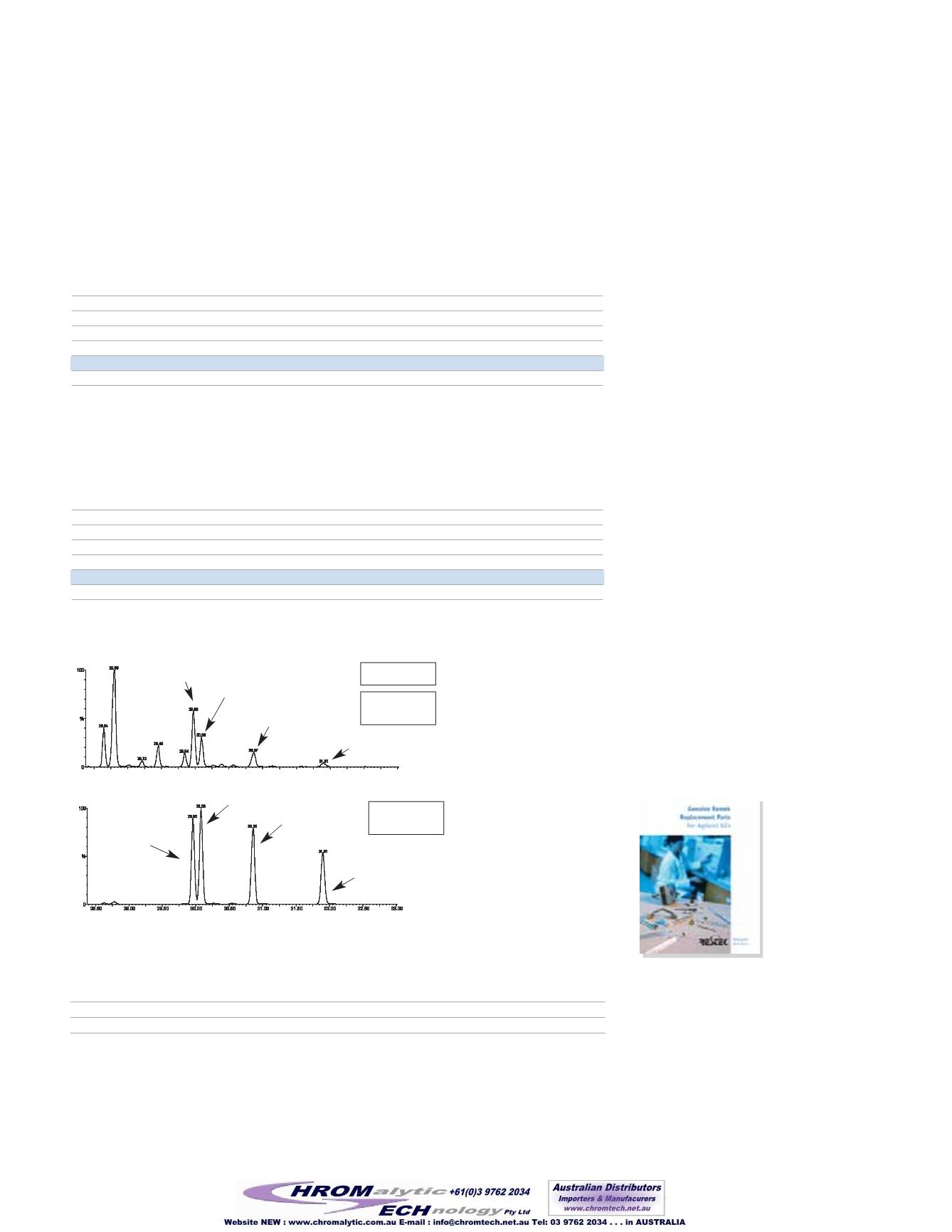

• 2 •
www.restekcorp.comQuantitation of the hexachlorodibenzofurans on
Rtx
®
-5 or equivalent columns, like quantitation of the
dioxins, can be made difficult by coelutions of toxic
and non-toxic congeners. The new column resolves
furan congeners as effectively as dioxins. Figure 2 is
a chromatogram for the HCDF congener group in
reference material WMS-01; the congeners are very
well resolved (reference material courtesy of
Wellington Laboratories, Guelph, Ontario, Canada).
Figure 2—
Hexachlorodibenzofuran congeners resolved by an Rtx®-Dioxin2 column.
Chromatogram courtesy of Karen MacPherson and Eric Reiner, Ontario Ministry of the Environment, Etobicoke, Ontario, Canada.
Table 1 lists values for 1,2,3,4,7,8-hexachlorodiben-
zofuran in several reference materials. In analyses
on 5-type stationary phases, a number of non-toxic
hexafuran congeners can coelute with the toxic
1,2,3,4,7,8-HCDF congener, producing inflated val-
ues for 1,2,3,4,7,8-HCDF. In fact, it is generally
assumed that in fly ash the actual value for
1,2,3,4,7,8-HCDF is approximately 3-fold less than
the value obtained when using a 5-type column. This
Table 2
—Values for 2,3,7,8-tetrachlorodibenzofuran in biota reflect the Rtx®-Dioxin2 column’s
ability to resolve target compounds from potentially interfering chlorodiphenylethers (all values pg/g;
provisional (non-2,3,7,8-TCDF confirmed)).
Column
Certified
5-type
225-type
Rtx®-Dioxin2
Value
Biota-1
1
1.3
0.8
Biota-2
4.3
4.3
2.2
Sediment
37
19
19
Fly ash
240
38
32
EC-2 (DX-1)
88
n/a
37
89 ±44
NST 1974
4.7
n/a
3.3
is one of the reasons confirmation on a high-cyano
phase is necessary. As shown in Table 1, the value
for 1,2,3,4,7,8-HCDF on an Rtx
®
-Dioxin2 column is
approximately 3-fold less than what was quantified
using a 5-type column. The difference is explained
by the excellent separation in Figure 2: the lower,
more accurate value is due to elimination of coelu-
tions with non-toxic congeners. Values for other
congeners compare equally well.
An additional advantage of the Rtx
®
-Dioxin2 column
is its ability to separate the chlorodiphenylethers,
commonly found in biota extracts, from the furans.
Coelution of these materials is a common problem
on both 5% diphenyl / 95% dimethyl stationary
phases and cyanopropyl stationary phases, but chro-
matographic separation is necessary for accurate
quantification of the chlorofurans: the
chlorodiphenylethers form chlorofurans in the ion
source of the mass spectrometer, and therefore can-
not be separated spectrally from the target com-
pounds. Table 2 summarizes results from analyzing
several matrices for 2,3,7,8-tetrachlorodibenzofuran
(2,3,7,8-TCDF). The values for the biota extracts
demonstrate the importance of the
furan/chlorodiphenylether separation. Because nei-
ther the 5% diphenyl / 95% dimethyl-type column
nor the cyanopropyl-type column solves the coelution
problem, quantified values for 2,3,7,8-TCDF in biota
are high for both columns. The Rtx
®
-Dioxin2 column
separates these compounds, and the quantified values
for 2,3,7,8-TCDF, approximately one-half of the values
obtained on the other stationary phases for these par-
ticular samples, are more accurate values.
If you are involved in analyzing dioxins and furans,
and would like detailed information about Rtx
®
-
Dioxin2 columns, we can provide elution orders for
all of the commonly analyzed congeners, and chro-
matograms for each congener group in the WMS-01
reference material. Please contact our Technical
Service chemists at 800-356-1688 or 814-353-1300,
ext. 4, or contact your Restek representative.
Native HCDFs
373.8207 m/z
WMS-01
C13 labels
331.9386 m/z
1,2,3,4,7,8-HCDF-C13
1,2,3,6,7,8-HCDF-C13
2,3,4,6,7,8-HCDF-C13
1,2,3,7,8,9-HCDF-C13
GC_EV00703
Table 1—
An Rtx®-Dioxin2 column gives more accurate quantitation than 5-type columns for
1,2,3,4,7,8-hexachlorodibenzofuran in common matrices (all values pg/g).
Certified
5-type column
Rtx®-Dioxin2 column
Value
Biota-1
nd
nd
Biota-2
nd
nd
Sediment
290
210
Fly ash
570
200
EC-2 (DX-1)
780
630
714 ±276
NST 1974
nd
nd
Rtx®-Dioxin2 Columns (fused silica)
ID
df (µm)
temp. limits
40-Meter
60-Meter
0.18mm 0.18
20°C to 320°C
10759
—
0.25mm 0.25
20°C to 320°C
—
10758
Additional columns for dioxins analysis
Rtx®-Dioxin,
60m, 0.25mm ID, 0.15µm, cat.# 10755, $715
Rtx®-Dioxin,
40m, 0.18mm ID, 0.11µm, cat.# 10756, $655
Rtx®-5,
60m, 0.25mm ID, 0.25µm, cat.# 10226, $705
Rtx®-5MS,
60m, 0.25mm ID, 0.25µm, cat.# 12626, $710
60m, 0.25mm ID, 0.25µm Rtx
®
-Dioxin2
(cat.# 10758)
Oven temp.:
130°C (hold 1 min.) to
205°C @ 45°C/min. to 305°C @
6°C/min. (hold 30 min.);
Dead time:
2.89 min.;
Carrier gas:
helium at
1.5mL/min., constant flow
Genuine
Restek
Replacement
Parts for
Agilent GCs
(lit. cat.# 59627D)
Restek chromatography
supplies and acces-
sories—designed by
chromatographers, for chromatographers.
This 50-page reference manual lists the consumer-
replaceable items, supplies, and accessories you need
to keep your Agilent GC running at top performance:
injector and inlet supplies, detector parts and supplies,
gas system components, tools, vials, syringes, and
much more. Many items have been designed to save
you time or improve your results, and are exclusive to
Restek. Many other items are manufactured
specifically to duplicate or exceed the performance of
the instrument manufacturer’s parts.
1,2,3,4,7,8-HCDF
1,2,3,6,7,8-HCDF
2,3,4,6,7,8-HCDF
1,2,3,7,8,9-HCDF


















